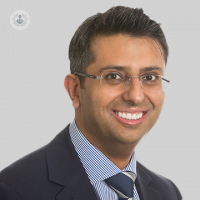Odontogenic sinusitis: causes, diagnosis and treatment
Escrito por:Your sinuses are hollow air-filled pouches behind your face that are designed to produce liquid, but sometimes, they can become blocked due to a spreading tooth infection. Mr Sam Khemani Is a highly skilled consultant ENT surgeon and here, he provides you with answers to commonly asked questions.

What is odontogenic sinusitis?
Sinusitis is the inflammation of one or multiple sinuses. Your sinuses are hollow air-filled cavities (like pouches) behind your forehead, cheeks and eyes. Odontogenic sinusitis is any inflammation of a dental origin and of your sinuses, it’s almost always one of the maxillary sinuses that is affected. These can be found to the right and left of your nose, behind the cheeks.
This condition occurs when a dental infection caused by lack of oral hygiene or dental surgery, such as tooth implants, a tooth removal or a sinus lift, reaches the maxillary sinus. Your teeth project up towards the maxillary sinus, and sometimes directly into it. There is a membrane called the Schneiderian membrane that protects your sinuses from teeth and teeth infections, but if surgery or a tooth’s root disrupt the membrane, the infection can spread.
Is it common?
Odontogenic sinusitis is quite common. About 10% of all sinus infections are odontogenic and the likelihood of this occurring increases as we age. For example, in a person who is 50 years old or older with an infection in one of the maxillary sinuses, the chance that it comes from a tooth infection is around 50%.
What are the symptoms?
Most people with odontogenetic sinusitis might not know that it’s caused by their teeth, simply because they don’t have any dental pain. However, the following symptoms can indicate sinusitis:
- Having a temperature
- Feeling congested ( blocked nose )
- Secretions into the nose
- Postnasal drip – when excess mucus drips down the back of the throat
- Loss of sense of smell
How is it diagnosed?
Anyone with the previously mentioned symptoms should be seen by an ENT surgeon. They will base a diagnosis on the patient’s symptoms and via diagnostic tests. A flexible nasal endoscopy is the most effective diagnostic test. A flexible tube with a camera at the end will be used to look inside the nose and check if secretions (that exit the natural drainage pathway of the maxillary sinus) are extra thick and if they flowing into the back of the nose. Plain x-rays often miss signs of the infection, so a CT scan is regularly used because it’s more detailed.
What treatment is available?
If odontogenic sinusitis is caught early, the tooth will be treated or removed. The patient will also be given antibiotic treatment and steroid nasal treatment (applied via spray or drops in the nose). Furthermore, saline irrigation (saltwater to wash out the infection) may be suggested. This combination of treatment works well and around 50% of cases are resolved this way.
For those who don’t respond, functional endoscopic sinus surgery (FESS ) is the next option. This is a day case surgery that involves the use of small endoscopes in the nose. It involves no external cuts and the aim is to open up the natural drainage path of the maxillary sinus into the nose. This procedure will relieve any obstruction of the sinus pathway and clear the infection out. In addition, it usually only results in short-term discomfort.
Does treatment involve any risks or side effects?
Non-surgical treatments are low risk. Surgical treatments are very straight-forward and also low-risk, however, there are two risks we always mention that are very rare. These are:
- Damage to the base of the skull, in which liquid from around the brain can leak into the nose.
- Damage to the bone that surrounds the eye. As these are exceedingly rare, treatments are almost always free of complications.
Visit Mr Sam Kheman’s profile to discover how he can assist you with looking after your ear, nose and throat.


